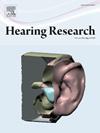用对侧窄带噪声激发器测量中耳声反射的频率和水平依赖性及其衰减
IF 2.5
2区 医学
Q1 AUDIOLOGY & SPEECH-LANGUAGE PATHOLOGY
引用次数: 0
摘要
声反射有可能作为一种诊断工具,用于识别耳蜗感觉神经元选择性损伤的个体(Bramhall等人,2022;Feeney et al., 2023;Wojtczak et al., 2017)。如果对神经元的损伤是局部的,那么使用宽带刺激来引发反射,正如上面引用的研究所报道的那样,可能不是最有效的揭示空间限制病变的方法。我们测量了吸收度的变化,啁啾传递到一只耳朵和对侧窄带噪声引起反射。我们的目的是表征不同中心频率的噪声引起的吸光度变化的频率和水平依赖性,以及长时间激发子反射的衰减,作为与疑似神经损伤个体的类似测量进行比较的基线。我们的假设是,优先激活反射通路受损部分的激发子将显示出与正常最大的偏差。我们已经确定了一种新的声反射敏化,在重复暴露于中等水平的激发子之后,与最低程度刺激的对侧耳相比,无论激发子的水平如何,吸光度都会发生两倍以上的变化。这些变化恢复得很慢。我们正在测量反射与激发子水平的增长以及恒定的激发子水平与中心频率的增长。我们还测量了反射衰减率与激发子中心频率的关系。初步发现证实了揭示个体和耳朵之间差异的测量方案。本文章由计算机程序翻译,如有差异,请以英文原文为准。
Frequency and level dependence of the middle ear acoustic reflex and its decay measured in wideband absorbance with contralateral narrowband noise elicitors
The acoustic reflex has potential as a diagnostic tool for identifying individuals with selective damage to cochlear sensory neurons (Bramhall et al., 2022; Feeney et al., 2023; Wojtczak et al., 2017). If damage to neurons is localized, then using broadband stimuli to elicit the reflex, as reported in the studies cited above, may not be most effective in revealing spatially restricted lesions. We have measured changes in absorbance with chirps delivered to one ear and contralateral narrowband noise to elicit the reflex. We aim to characterize the frequency and level dependence of changes in absorbance elicited by noise with different center frequencies as well as the decay of the reflex for prolonged elicitors as a baseline for comparison with similar measurements in individuals suspected of having neural damage. Our hypothesis is that elicitors that preferentially activate the damaged part of the reflex pathway will show the largest deviation from normal. We have identified a novel sensitization of the acoustic reflex following repeated exposure to moderate level elicitors such that absorbance changes more than double, regardless of the level of the elicitor, compared with the minimally stimulated contralateral ear. These changes recover slowly. We are measuring the growth of the reflex vs elicitor level and at constant elicitor level vs center frequency. We are also measuring the rate of reflex decay vs elicitor center frequency. Preliminary findings substantiate the measurement protocols in revealing differences between individuals and ears.
求助全文
通过发布文献求助,成功后即可免费获取论文全文。
去求助
来源期刊

Hearing Research
医学-耳鼻喉科学
CiteScore
5.30
自引率
14.30%
发文量
163
审稿时长
75 days
期刊介绍:
The aim of the journal is to provide a forum for papers concerned with basic peripheral and central auditory mechanisms. Emphasis is on experimental and clinical studies, but theoretical and methodological papers will also be considered. The journal publishes original research papers, review and mini- review articles, rapid communications, method/protocol and perspective articles.
Papers submitted should deal with auditory anatomy, physiology, psychophysics, imaging, modeling and behavioural studies in animals and humans, as well as hearing aids and cochlear implants. Papers dealing with the vestibular system are also considered for publication. Papers on comparative aspects of hearing and on effects of drugs and environmental contaminants on hearing function will also be considered. Clinical papers will be accepted when they contribute to the understanding of normal and pathological hearing functions.
 求助内容:
求助内容: 应助结果提醒方式:
应助结果提醒方式:


